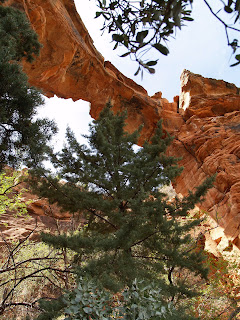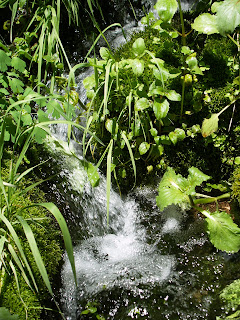



Sometimes a little confusion makes for a good team-building exercise. That’s what we got while hiking the Indian Farm Trail. Or, at least we THINK we hiked the Indian Farm Trail. Our first mistake was to trust the hike description given in a popular hiking book which turned out to be over simplified and rife with typos---noteworthy among them was the back-ackwards FS road number which makes up the majority of the hike. Next, the maps in the book showed the route as a straight-forward path. However, what we found was that the area is riddled with a maze of unnamed 4x4 roads and informal trails—none of which appear on the forest servce maps or in the National Geo TOPO software. Soooo, we decided to trudge along anyway, using GPS waypoints and carin-building to create our own route. (see details below) We were not disappointed.
After a short, uphill climb, the trail dips down into Tonto basin—a sprawling river gorge flanked by desert mountain peaks. After about a half-mile of hiking, the sycamore-and-cottonwood-lined river channel is visible below the trail. The floodplain is massive—sinuous, wide and feeding a healthy band of green where birds of all sorts populate the trees and shorelines. The road we followed ends roughly a quarter mile from the creek. At this point, it became necessary to plot many waypoints and build elaborate cairns so we would be able to find our way back through the dense mesquite bosque and clusters of sycamore and cottonwood trees. Exploring along the creek is a blast. There are lots of reed-choked coves, riffles, fishin’ holes and sandy beaches to hold your interest.
Although we found some corral ruins and a pipe that may have been a well; we doubt it was the Indian Farm described in the book. No matter; it was a great day on the trail.
LENGTH: 6 miles round trip
ELEVATION: 1550-3,036 feet
RATING: moderate hiking, difficult route-finding
IMPORTANT NOTE: this trail is closed December thru June to protect nesting native birds.
GETTING THERE:
From Phoenix, go north on Highway 87 to the Gisela Road (FR 417) which is located just north of milepost 239. Turn right onto FR 417 and then take the first right onto FR 184. Follow FR 184 for 3.8 miles to FR 1434, a steep Jeep road on the left side of the road. (if you get to the metal bridge, you have gone too far). Park in the turnoffs along FR 417.
THE HIKE:
From FR 417, hike uphill along FR 1434.
1st junction: stay right and go downhill.
2nd Junction: continue straight down a narrow road.
Cross a wash.
3rd Junction: near the 1-mile point, stay straight. The spur trail on the right leads to a scenic campsite over Tonto Creek and is worth the quarter-mile it adds to the trip.
4th Junction: at a wash, go left, then take an immediate right on to the road that heads uphill.
5th Junction: cross the wash and continue straight.
6th Junction: go straight.
After the 6th junction, the trail narrows and heads steeply downhill on a twisting path that leads to a sandy wash at the edger of the flood plain. Here is where route finding becomes critical. Mark your path and bush whack your way down to the creek. From here, head north, making up your adventure as you go.















































